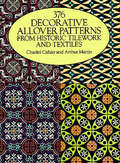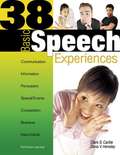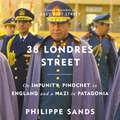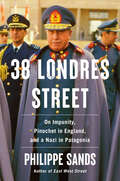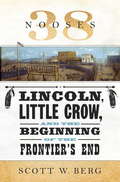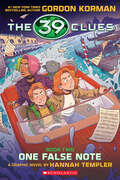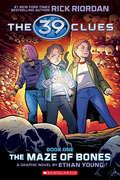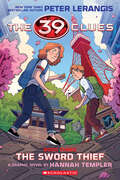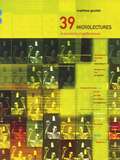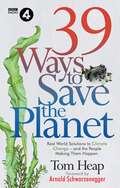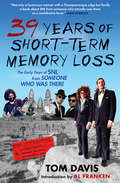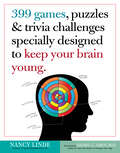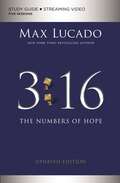- Table View
- List View
37 Things I Love (in no particular order)
by Kekla MagoonA powerful story about friendship, death, and figuring out who you are, from the author of How It Went Down, The Rock and the River, and X: A Novel (with Ilyasah Shabazz) <P><P>Ellis only has four days of her sophomore year left, and summer is so close that she can almost taste it. But even with vacation just within reach, Ellis isn't exactly relaxed. Her father has been in a coma for years, the result of a construction accident, and her already-fragile relationship with her mother is strained over whether or not to remove him from life support. Her best friend fails even to notice that anything is wrong and Ellis feels like her world is falling apart. But when all seems bleak, Ellis finds comfort in the most unexpected places.
375 Dinners on a Budget
by Cynthia Macgregor375 delicious, easy dinners that are ready for you to cook. Use them for all situations as a family. Recipes are organized by main food type (Chicken, Pork and Ham, Pasta, Ground Beef, etc.). Get ready for some great meals for you and your family.
376 Decorative Allover Patterns from Historic Tilework and Textiles (Dover Pictorial Archive)
by Arthur Martin Charles CahierThe increased use of quality designs in 19th-century manufactured goods created a steady demand during that period for collections of decorative patterns. This volume reproduces one such collection - an extremely rare and valuable portfolio of 376 motifs assembled more than a century ago by two French Jesuit scholars. Relying on historical wall and floor tiles, textile patterns, tapestries, wall hangings, and other designs originating in the Middle Ages, the Renaissance, and later European and Islamic cultures, Charles Cahier (1807-1882) and Arthur Martin (1802-1856) produced a work of true artistic distinction. Included are a wealth of splendid floral, animal, bird, and geometric patterns, carefully researched and meticulously redrawn for use in a myriad of graphic and artistic projects. Many of the motifs are accompanied by complementary border designs, an often essential accessory. This edition faithfully reproduces the edition published in 1868, titled Suite aux mélanges d'archéologie. It represents an invaluable copyright-free resource embodying the finest designs from historic sources, ready for use by artists, illustrators, craftspeople, and designers working with textiles, wallpapers, interior decoration, and other projects.
38 Basic Speech Experiences (11th Edition)
by Clark S. Carlile Dana V. HensleyThis book provides guidance on Personal Speeches, Speeches to Share Information, Speaking Persuasively, Social, Speeches for Special Occasions, Contest Speaking, Business and Career Speaking, and The Mass Media.
38 Londres Street: On Impunity, Pinochet in England and a Nazi in Patagonia
by Philippe SandsIn 38 Londres Street, Philippe Sands blends personal memoir, historical detective work and gripping courtroom drama to probe a secret double story of mass murder, one that reveals a shocking thread that links the horrors of the 1940s with those of our own times. The house at 38 Londres Street is home to the legacies of two men whose personal stories span continents, nationalities and decades of atrocity: Augusto Pinochet, President of Chile, and Walther Rauff, a Nazi SS officer responsible for the use of gas vans.On the run from justice at the end of the Second World War, Rauff crosses the ocean to southern Chile. He settles in Punta Arenas, Patagonia, managing a king crab cannery at the end of the world. But there are whispers about this discreet and self-possessed German - rumours of a second career with Pinochet's secret intelligence service, the dreaded DINA.In 1998, Pinochet is in a London medical clinic when the police enter his room and arrest him on charges of crimes against humanity and genocide. Philippe Sands is called to advise the former head of state on his claim to immunity, but will instead represent a human rights organisation against him. Years later, Sands makes a discovery while working on another book which reignites his interest in the case and leads to a decades-long investigation into Pinochet's crimes, his unexpected connection to Rauff and the former Nazi's possible connection to Chile's disappeared.
38 Londres Street: On Impunity, Pinochet in England and a Nazi in Patagonia
by Philippe SandsIn 38 Londres Street, Philippe Sands blends personal memoir, historical detective work and gripping courtroom drama to probe a secret double story of mass murder, one that reveals a shocking thread that links the horrors of the 1940s with those of our own times. The house at 38 Londres Street is home to the legacies of two men whose personal stories span continents, nationalities and decades of atrocity: Augusto Pinochet, President of Chile, and Walther Rauff, a Nazi SS officer responsible for the use of gas vans.On the run from justice at the end of the Second World War, Rauff crosses the ocean to southern Chile. He settles in Punta Arenas, Patagonia, managing a king crab cannery at the end of the world. But there are whispers about this discreet and self-possessed German - rumours of a second career with Pinochet's secret intelligence service, the dreaded DINA.In 1998, Pinochet is in a London medical clinic when the police enter his room and arrest him on charges of crimes against humanity and genocide. Philippe Sands is called to advise the former head of state on his claim to immunity, but will instead represent a human rights organisation against him. Years later, Sands makes a discovery while working on another book which reignites his interest in the case and leads to a decades-long investigation into Pinochet's crimes, his unexpected connection to Rauff and the former Nazi's possible connection to Chile's disappeared.
38 Londres Street: On Impunity, Pinochet in England, and a Nazi in Patagonia
by Philippe SandsIn this intimate legal and historical detective story, the world-renowned lawyer and acclaimed author of East West Street traces the footsteps of two of the twentieth century&’s most merciless criminals—accused of genocide and crimes against humanity—testing the limits of immunity and impunity after Nuremberg.&“Though nearly a decade in the making, this book could not arrive at a better time, because its subject is one of the most pressing themes of our era: impunity. . . . Sands has created an indelible and enthralling work of moral witness.&” —Patrick Radden Keefe, author of Say NothingOn the evening of October 16, 1998, Chilean dictator Augusto Pinochet was arrested at a medical clinic in London. After a brutal, seventeen-year reign marked by assassinations, disappearances, and torture—frequently tied to the infamous detention center at the heart of Santiago, Londres 38—Pinochet was being indicted for international crimes and extradition to Spain, opening the door to criminal charges that would follow him to the grave, in 2006.Three decades earlier, on the evening of December 3, 1962, SS-Commander Walter Rauff was arrested in his home in Punta Arenas, at the southern tip of Chile. As the overseer of the development and use of gas vans in World War II, he was indicted for the mass murder of tens of thousands of Jews and faced extradition to West Germany.Would these uncommon criminals be held accountable? Were their stories connected? The Nuremberg Trials—where Rauff&’s crimes had first been read into the record, in 1945—opened the door to universal jurisdiction, and Pinochet's case would be the first effort to ensnare a former head of state.In this unique blend of memoir, courtroom drama, and travelogue, Philippe Sands gives us a front row seat to the Pinochet trial—where he acted as a barrister for Human Rights Watch—and teases out the dictator&’s unexpected connection to a leading Nazi who ended up managing a king crab cannery in Patagonia. A decade-long journey exposes the chilling truth behind the lives of two men and their intertwined destinies on 38 Londres Street.
38 Nooses: Lincoln, Little Crow, and the Beginning of the Frontier's End
by Scott W. BergIn August 1862, after decades of broken treaties, increasing hardship, and relentless encroachment on their lands, a group of Dakota warriors convened a council at the tepee of their leader, Little Crow. Knowing the strength and resilience of the young American nation, Little Crow counseled caution, but anger won the day. Forced to either lead his warriors in a war he knew they could not win or leave them to their fates, he declared, "[Little Crow] is not a coward: he will die with you." So began six weeks of intense conflict along the Minnesota frontier as the Dakotas clashed with settlers and federal troops, all the while searching for allies in their struggle. Once the uprising was smashed and the Dakotas captured, a military commission was convened, which quickly found more than three hundred Indians guilty of murder. President Lincoln, embroiled in the most devastating period of the Civil War, personally intervened in order to spare the lives of 265 of the condemned men, but the toll on the Dakota nation was still staggering: a way of life destroyed, a tribe forcibly relocated to barren and unfamiliar territory, and 38 Dakota warriors hanged--the largest government-sanctioned execution in American history. Scott W. Berg recounts the conflict through the stories of several remarkable characters, including Little Crow, who foresaw how ruinous the conflict would be for his tribe; Sarah Wakefield, who had been captured by the Dakotas, then vilified as an "Indian lover" when she defended them; Minnesota bishop Henry Benjamin Whipple, who was a tireless advocate for the Indians' cause; and Lincoln, who transcended his own family history to pursue justice.Written with uncommon immediacy and insight, 38 Nooses details these events within the larger context of the Civil War, the history of the Dakota people, and the subsequent United States-Indian wars. It is a revelation of an overlooked but seminal moment in American history.
38 Recipes for Chocolate Desserts. Diabetics and Special Diets
by Nadia Hleb Henry C. MederoDo you love chocolate, but you can't eat sugar? Enjoy all the benefits of chocolate without remorse. In this book, you'll find 38 wonderful recipes for chocolate desserts, specially designed for quick and easy preparation. These desserts can be eaten by anybody with diabetes or those on a special diet.
39 Clues: One False Note: A Graphic Novel (The 39 Clues)
by Gordon KormanThe second installment in the mega-bestselling The 39 Clues series, now in graphic novel form!Amy and Dan made the choice of a lifetime when they gave up a million dollars in favor of a Clue and joined a competition unlike any the world has ever seen. After barely escaping Paris with their lives, now they're in Vienna to discover the truth about their famous ancestor, Wolfgang Amadeus Mozart, and the long-buried secrets connected to his equally talented but overlooked sister, Nannerl.But with their enemies closing in, Amy and Dan must decide how much they're willing to risk to find the clues, and who they're willing to betray in the process...
39 Clues: The Maze of Bones: A Graphic Novel (39 Clues Graphic Novel #1)
by Rick RiordanThe graphic novel adaptation of the mega-bestseller that launched a global phenomenon!Minutes before she died Grace Cahill changed her will, leaving her decendants an impossible decision: "You have a choice - one million dollars or a clue."Grace is the last matriarch of the Cahills, the world's most powerful family. Everyone from Marie Curie to Harry Houdini is related to the Cahills, yet the source of the family power is lost. 39 Clues hidden around the world will reveal the family's secret, but no one has been able to assemble them. Now the clues race is on, and young Amy and Dan must decide what's important: hunting clues or uncovering what REALLY happened to their parents.
39 Clues: The Sword Thief: A Graphic Novel (The 39 Clues)
by Peter LerangisThe third installment in the mega-bestselling The 39 Clues series, now in graphic novel form!ATTENTION! Amy and Dan Cahill have been located once again, this time in the company of the notoriously unreliable Alistair Oh. Could they have been foolish enough to make an alliance?Spies report that Amy and Dan seem to be tracking the life of one of the most powerful fighters the world has ever known. If this fearsome warrior was a Cahill, his secrets are sure to be well-guarded... and the price to uncover them just might be lethal.
39 Microlectures: In Proximity of Performance
by Matthew Goulish'A series of accidents has brought you this book. You may think of it not as a book, but as a library, an elevator, an amateur performance in a nearby theatre. Open it to the table of contents. Turn to the page that sounds the most interesting to you. Read a sentence or two. Repeat the process. Read this book as a creative act, and feel encouraged.' 39 Microlectures: In Proximity of Performance is a collection of miniature stories, parables, musings and thinkpieces on the nature of reading, writing, art, collaboration, performance, life, death, the universe and everything. It is a unique and moving document for our times, full of curiosity and wonder, thoughtfulness and pain. Matthew Goulish, founder member of performance group Goat Island, meditates on these and other diverse themes, proving, along the way, that the boundaries between poetry and criticism, and between creativity and theory, are a lot less fixed than they may seem. The book is revelatory, solemn yet at times hilarious, and genuinely written to inspire - or perhaps provoke - creativity and thought.
39 Ways to Save the Planet
by Tom HeapWe got ourselves into this. Here's how we can get ourselves out.We know the problem: the amount of biodiversity loss, the scale of waste and pollution, the amount of greenhouse gas we pump into the air... it's unsustainable. We have to do something. And we are resourceful, adaptable and smart. We have already devised many ways to reduce climate change - some now proven, others encouraging and craving uptake. Each one is a solution to get behind.In 39 Ways to Save the Planet, Tom Heap reveals some of the real-world solutions to climate change that are happening around the world, right now. From tiny rice seeds and fossil fuel free steel to grazing elk and carbon-capturing seagrass meadows, each chapter reveals the energy and optimism in those tackling the fundamental problem of our age. Accompanying a major BBC Radio 4 series in collaboration with the Royal Geographical Society, 39 Ways to Save the Planet is a fascinating exploration of our attempt to build a better future, one solution at a time. A roadmap to global action on climate change, it will encourage you to add your own solutions to the list.
39 Years of Short-Term Memory Loss: The Early Days of SNL from Someone Who Was There
by Al Franken Tom DavisThirty-Nine Years of Short-term Memory Loss is a seriously funny and irreverent memoir that gives an insider’s view of the birth and rise of Saturday Night Live, and features laugh-out-loud stories about some of its greatest personalities-Al Franken, Lorne Michaels, Dan Aykroyd, John Belushi, Bill Murray, Michael O’Donoghue, and Chris Farley. Tom Davis’s voice is rich with irony and understatement as he tells tales of discovery, triumph, and loss with relentless humor. His memoir describes not only his experiences on the set of SNL but also his suburban childhood, his high school escapades in the '60s, his discovery of sex, and how he reveled in the hippie culture-and psychoactive drugs-from San Francisco to Kathmandu to Burning Man over the last four decades. Hysterical, lucid, and wise, Thirty-Nine Years of Short-term Memory Loss is an unforgettable romp in an era of sex, drugs, and comedy.
399 Games, Puzzles & Trivia Challenges Specially Designed to Keep Your Brain Young.
by Nancy LindeCross-train your brain. All it takes is ten to fifteen minutes a day of playing the right games. (It&’s fun.) Exercising your brain is like exercising your body—with the right program, you can keep your brain young, strong, agile, and adaptable. Organized on an increasing scale of difficulty from &“Warm-up&” to &“Merciless,&” here are 399 puzzles, trivia quizzes, brainteasers, and word game that are both fun and engaging to play, and are expertly designed to give your brain the kind of workout that stimulates neurogenesis, the process of rejuvenating the brain by growing new brain cells. Target Six Key Cognitive Functions: 1. Long-Term Memory. 2. Working Memory. 3. Executive Functioning. 4. Attention to Detail. 5. Multitasking. 6. Processing Speed.
3: A Study for Small Groups
by Max LucadoA twenty-six word parade of hope: beginning with God, ending with life, and urging us to do the same. Brief enough to write on a napkin or memorize in a moment, yet solid enough to weather two thousand years of storms and questions. If you know nothing of the Bible, start here. If you know everything in the Bible, return here. We all need the reminder. The heart of the human problem is the heart of the human. And God's treatment is prescribed in John 3:16: For God so loved the world that he gave his one and only Son that whosoever believes in Him shall not perish but have eternal life. He loves. He gave. We believe. We live.
3: And Other Meshugeh Tales of the Yiddish West
by Zane GreybergFunnier than Blazing Saddles! --Charles Dickenstein, author of A Tale of Two Sidneys Did the Jews really tame the American frontier? You bet your tuchas. Brave, rugged Jews with big dreams and even bigger shmeckles. Shtarkers like Davy Kronsky. The Ringo Kiddish. The mysterious Man with No Yarmulke. Jewish Indian tribes like the Mishagossi and Grossinga who would never scalp on the Sabbath.These are their stories, told for the first time. So pay attention.SHE WORE A YELLOW SHMATTATHE GOOD, THE BAD, AND THE FARBLONDJETTHE MAGNIFICENT $7 (NOW MARKED DOWN TO $5.98) TWO MOYELS FOR SISTER SARA. A FISTFUL OF DREIDELSCHAI NOONTHE WILD BRUNCHAnd a lot more, you should only know. The critics won't shut up already about this book! "Funnier than a passle of stuffed dermas!' --Melvin "Six-Gun" Shapiro, foreman, Bar-Mitzvah Ranch"From snow you can't make a cheesecake." --J. D. Salinsky, author of The Kvetcher in the Rye Did somebody say, "Go West, Youngman"? Zane Greyberg, born Leo Kloppman in Brooklyn, New York, has held a variety of jobs, from chicken flicker to pickle-maker, before he turned to writing. His first book, Shangri-Latkes and Other Lost Horizons was published in 1999 and completely befuddled critics. Roderick Pish-Tipple of the Hackensack Jewish Weekly said, "You call this poetry? It doesn't even rhyme. What's with this Greyberg guy--he drinks maybe?" Mr. Zaneberg lives, he says, "wherever the wind blows and the cream cheese is fresh."
3: Bear Hug (WILD)
by Lucy CourtenayFeaturing tiger cubs, circus bears, swimming monkeys and cute koalas - this is a must-read series for all animal lovers!Twins Tori and Taya Wild disagree about almost everything ... except for their love of animals! That's a good thing, too, since their mother fosters all kinds of wild animals so their house is always full of them! And now their family has set up an 'animals on film' business their lives have become even WILDER. When her father has to find a cast of horses for a TV period drama Taya thinks it's finally her time to be the STAR. She's desperate to be the one in front of the camera for once. But she's in danger of being upstaged by Boris, the tiny Russian circus bear cub her mum is fostering, who could end up stealing the show ...
3: The Numbers of Hope
by Max LucadoIf 9/11 are the numbers of terror and despair, then 3:16 are the numbers of hope. Best selling author Max Lucado leads readers through a word-by-word study of John 3:16, the passage that he calls the "Hope Diamond" of scripture.
3: The Numbers of Hope
by Max LucadoIn the million-selling favorite, best-selling author Max Lucado leads readers through a word-by-word study of John 3:16, the passage that he calls the "Hope Diamond" of Scripture.A twenty-six word parade of hope: beginning with God, ending with life, and urging us to do the same. Brief enough to write on a napkin or memorize in a moment, yet solid enough to weather two thousand years of storms and questions. If you know nothing of the Bible, start here. If you know everything in the Bible, return here. We all need the reminder. The heart of the human problem is the heart of the human. And God's treatment is prescribed in John 3:16: For God so loved the world that he gave his one and only Son that whosoever believes in Him shall not perish but have eternal life. He loves. He gave. We believe. We live.Believers and seekers alike have flocked to this hope and continue to share this message with those they love.
3: The Numbers of Hope
by Max Lucado*Now with brand-new content added, one of Max Lucado&’s all-time bestselling books is updated for a new generation!*Sometimes life appears to fall to pieces and can seem irreparable. We&’ve all had our fair share of disappointments, loss, or hardships. But for every challenge there is a breathtaking promise: It&’s going to be okay. How can we know? Because God so loved the world.In 3:16, pastor and New York Times bestselling author Max Lucado encourages us to study closely the &“Hope Diamond of the Bible&”: John 3:16.Max says of his favorite verse, &“Every time I recall these words, they are fresh and as stunning as my first encounter with them. The mind-bending awareness of God&’s limitless love, his incalculable sacrifice, and the priceless teaching at the core. How can we not review it again and again? I want this generation, and all who come after, to look closely at the key promise of God and choose the gift beyond all gifts.&”Throughout this updated and expanded edition of 3:16, Max will invite you to:Stand in awe of how deep, wide, long, and high God&’s love is for youUnderstand more fully the living hope you have through Jesus&’ death and resurrectionRest in the assurance that salvation is a gift from God, not something you can earnIf you know nothing of the Bible, start here. John 3:16 invites you to know God&’s love deeply and intimately. And once you accept God&’s love, your life will never be the same.If you know everything in the Bible, return here. Let John 3:16 become the banner of your life, so much so that the message of God&’s unending and unbending love overflows from you to others.Each copy of 3:16 also includes a 40-day devotional designed to help you draw closer to your loving Savior.
3: The Numbers of Hope
by Max LucadoExperience the essential truth of the Christian faith as Max Lucado unpacks one of the most beloved scriptures in the entire Bible--John 3:16. Best-selling author Max Lucado leads readers through a word-by-word study of John 3:16, the passage that he calls the "Hope Diamond" of Scripture. Now available in a smaller, more affordable format, the study includes 12 lessons that are designed to work with both the trade book and the DVD for a multi-media experience.Features include: Scripture-focused lessonsInteractive questions for reflection and meditation12 weeks of studyLeader's Guide for shepherding small groups (for download online)Designed for use with the 3:16 DVD-Based Small Group Study (ISBN 9781418548940).
3: The Numbers of Hope
by Max Lucado*Entirely rewritten and re-filmed for a more focused and deeply personal study of the most-loved verse in the Bible—John 3:16.In this updated classic Bible study (video streaming included), bestselling author and pastor Max Lucado pulls back the curtain on his favorite Bible passage to move you to a profound awareness of God's limitless love, His incalculable sacrifice, and the certainty of His offer of eternal life."For God so loved the world that he gave his one and only Son, that whoever believes in him shall not perish but have eternal life." This passage is a twenty-six-word parade of hope. A verse brief enough to write on a napkin or memorize in a moment...and solid enough to weather 2,000 years of storms and questions.With deeply personal accounts of the way this verse shaped Max's own faith journey, this study will reveal the gospel story surrounding the promise and unpack God's plan of restoration from the human problems of sin and death. If you know nothing about the Bible, the promise of John 3:16 is where to start.It's time to live as if you've been "born again", as if you've already been redeemed. It's time to live into the promise, to trust it—so much that this message of God's unending love overflows from you to the world.This video study guide has everything you need for a full Bible study experience, including:The study guide itself—with discussion and reflection questions, video notes, and a leader's guide.An individual access code to stream all five video sessions online (DVD also available separately).Streaming video access code included. Access code subject to expiration after 12/31/2027. Code may be redeemed only by the recipient of this package. Code may not be transferred or sold separately from this package. Internet connection required. Void where prohibited, taxed, or restricted by law. Additional offer details inside.
3: The Numbers of Hope-Teen Edition
by Max LucadoBased on the beloved verse of John 3:16, Max Lucado brings insight to help teens apply this important teaching to their lives. 3:16 is certain to be one of Max's most important titles ever. Max offers his unique and simple storytelling for this important message while Tricia Goyer writes teen responses to Max's message, guiding teens to fully understand how this verse can impact their lives. From confession to praise, these responses are sure to bring an insightful look into the personal faith of teens. Note: White silicone bracelet no longer available with this edition. To order bracelet seperately, use ISBN 9781400312634.


